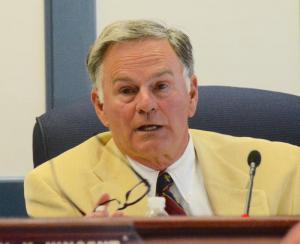Sussex County Council has passed a new sign ordinance, and in the process lifted a 13-month moratorium on new billboards. After four hours of debate Oct. 11, the new measure passed 5-0.
Among significant new regulations, some forms of animation – including video – will be allowed on on-premises electronic signs, and restrictions on how fast images on the sign could change have been lifted.
Also, the separation distance between billboards has been doubled to 600 feet and larger and taller billboards are now allowed on four-lane highways. In addition, no variances will be permitted for new billboards. The new ordinance went into effect as soon as council adopted it. Many of the changes were made to reflect current trends in the sign industry.
The updated ordinance includes new regulations pertaining to billboards and on- and off-premises electronic message centers, known as digital signs. Many of the county's sign regulations dated back 30 years. The final regulations are a compilation of proposed ordinances from council, the planning and zoning commission and a working group of stakeholders.
Councilman Rob Arlett, R-Frankford, called the new regulations a great piece of compromise.
Debate on sign regulations started last September when council enacted a billboard application moratorium after receiving a letter from the county's board of adjustment. In the letter, the five board members said regulations were vague and did not provide clear-cut standards to restrict or deny applications. They asked council for better direction.
Council discussed and voted in favor of eight of 14 amendments to the ordinance proposed by the planning and zoning commission and sign company owners.
Under the current system, billboards are permitted only in commercial zones and only with a special-use exception approved by the county board of adjustment. None of that changes.
But a major change is that no variances are allowed for new billboards, action that the working group did not support.
In the past, most billboard applications included some type of variance, usually for size and height.
For older, nonconforming billboards a variance from setback or separation distances could be approved by the board of adjustment if the board determines the overall nonconformity is substantially reduced by installation of the replacement sign. Variances from height and size requirements are not permitted.
Much of debate centers around animation
In support of a planning and zoning recommendation, council voted 3-2 to lift a prohibition on animation. Council members George Cole, R-Ocean View, and Joan Deaver, D-Rehoboth Beach, voted against the amendment.
Now, on-premises digital signs may use features such as video and dissolve, fade, flip or window shade movements but they cannot use continuous scrolling, live action or streaming video or flashing messages.
Council also voted 4-1 to remove transitional timing for on-premises electronic signs and to prohibit animation on digital billboards. That change allows time for signs to display animation on on-premises signs.
After voting for that amendment, Cole tried to get council to pass another amendment to add timing to the updated ordinance. His motion failed 3-2.
By not including transition time for on-premises electronic signs, Cole said council is opening a can of worms. “Why are we playing this game?” he asked. “We need to keep it simple because we have to enforce this.”
He said including a 10-second message with a 1-second transition time had been agreed to and was included in council's proposed ordinance. That timing was added to the ordinance for digital billboards, but not on-premisses digital signs.
Under the new ordinance, electronic message signs are permitted in residential zoning districts as long as a conditional-use application is approved.
That regulation did not please Cole. “The underlying zoning is important to protect; we have to protect the residential character of neighborhoods in Sussex County,” he said. “An electronic message sign in neighborhoods is just wrong.”
Arlett said council could revisit the timing issue.
“It took 20 years to get to this,” Cole responded. “Don't mislead the public because this is not easily amended,” he said.
Council takes on action on some amendments
Council did not take action on an amendment to change the front setback for billboards from 40 feet in the new ordinance to 25 feet, which has been the county standard.
Assistant county attorney Jamie Sharp told council that planning and zoning commissioners were concerned that the extended distance could prohibit some business owners from putting up a wall sign or ground sign for their business because of the distance from a billboard on or off their property.
After not voting, Council President Mike Vincent, R-Seaford, said, “We have potentially taken away a person's ability to advertise their business.”
Council also left in place a separation distance of 150 feet from property lines between billboards and churches, schools, dwellings and public lands. Planning and zoning commissioners and the working group supported a 300-foot separation distance.
The new ordinance allows temporary realtor and construction signs up to 32 square feet on large lots. The limit for temporary signs on a single dwelling lot in a recorded subdivision remains 10 square feet.
At a later date, officials will debate possible amendments to other sections of the sign ordinance, including on-premises signs, feather flags and so-called bandit signs that appear on weekends when county enforcement officials are not on duty.
Among the regulations:
• Separate billboard regulations for 2- and 4-lane roads including maximum heights of 25 feet on 2-lane roads and 35 feet on 4-lane roads measured from ground level.
• Applications for billboards on Route 1, Route 13, Route 113 and Route 9 must contain a letter of no objection from the Delaware Department of Transportation.
• Maximum billboard sign area of 300 square feet on 2-lane roads and 600 square feet on 4-lane roads.
• No stacked or side-by-side billboards.
• Variances for replacement billboards only for setbacks and separation distances and not for height or face size.
• Separation distance of 150 feet from a new billboard and property containing a church, school, dwelling or public lands, measured from the property line.
• Separation distance of 600 feet between billboards on all roads measured in a circle or radius on 2-lane roads and on the same side of the road on 4-lane roads.
• On-premises electronic message centers can be up to 200 square feet.
• Digital billboards are permitted in the same zoning districts as other billboards with a separation distance of 1,200 feet on 2-lane roads and 2,500 feet on 4-lane roads.



























































